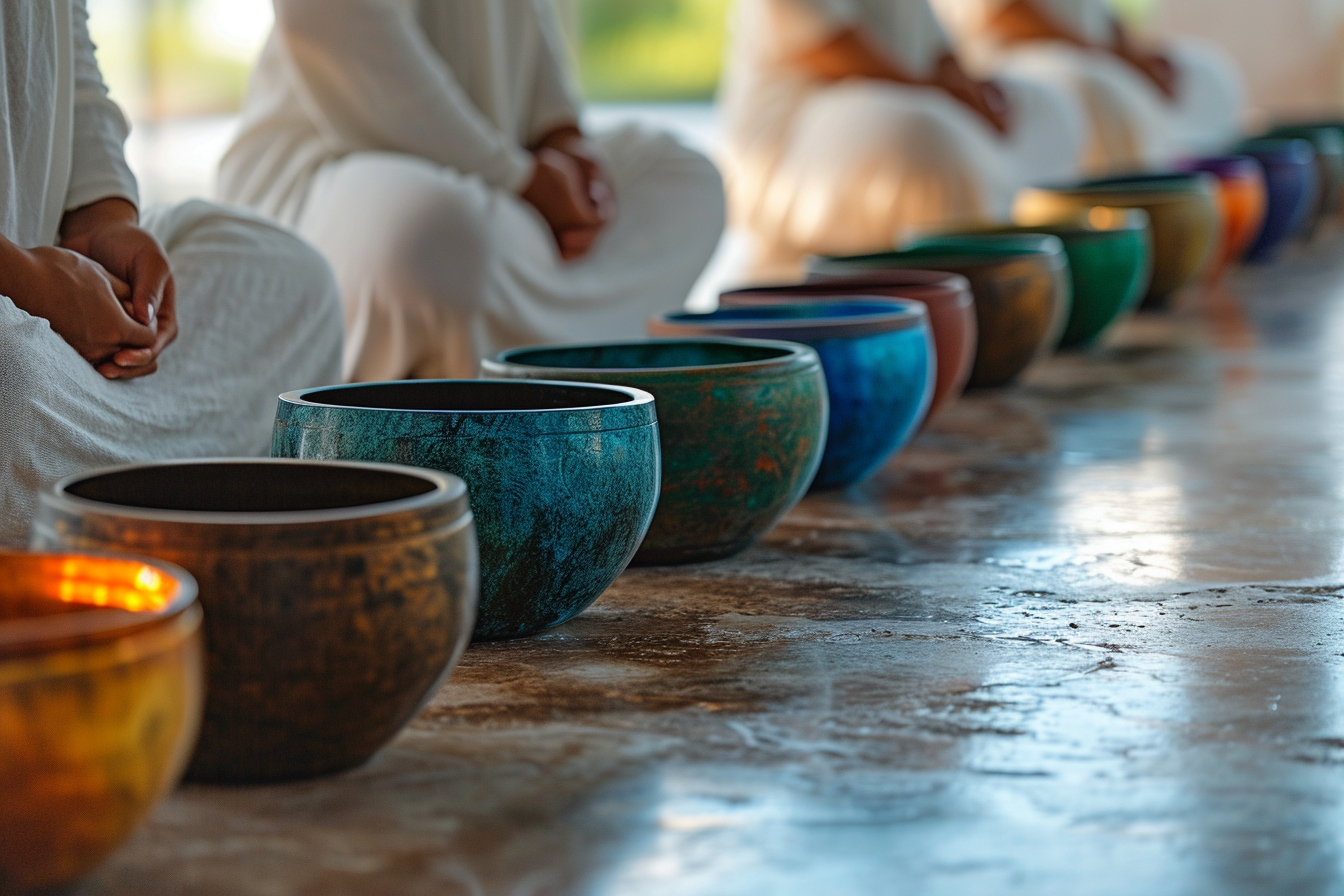Tibetan bowls, also known as singing bowls, Himalayan bowls, or suzu gongs, are a type of bell that vibrates and produces a rich, deep tone when played. Traditionally, these bowls originate from various regions across Asia including Tibet, Nepal, and India. Many users not only admire these instruments for their musical qualities but also for their potential benefits in meditation practices.
Understanding tibetan bowls: the foundation of sound meditation
The unique sounds emanating from Tibetan bowls are credited with facilitating deep relaxation and fostering an environment conducive to meditation. To fully appreciate the practice, it becomes imperative to delve into the characteristics and history of these remarkable instruments.
Origin and craftsmanship
Crafted from a variety of metals, including gold, silver, copper, iron, tin, mercury, and lead—which correspond to different celestial bodies—Tibetan bowls produce a complex amalgamation of harmonic overtones. The making of these bowls is a time-honored tradition, relying on techniques passed down through generations. The precise metal composition and crafting method contribute significantly to the sonic qualities of the bowl.
Acoustic properties and harmonics
The harmonic vibrations of Tibetan bowls are said to resonate with the body’s own vibrational frequencies. When played, they produce sounds that vary based on size, thickness, and composition, each influencing the pitch and overtones produced. It is these acoustic properties that facilitate deeper states of awareness during meditation.
The practice of sound meditation with tibetan bowls

Meditation with Tibetan bowls involves more than just passive listening. It is an immersive experience that integrates the mind, body, and spirit through focused attention on the sounds and vibrations.
Techniques of sound generation
Generating sound from a Tibetan bowl can be achieved using two principal techniques: striking and singing. Striking the bowl with a mallet produces a gong-like sound, setting the tone for the meditation. ‘Singing’ the bowl—where one gently rubs the rim with a wooden or leather-wrapped mallet—elicits sustained harmonious tones. These techniques can be mastered with practice and experimentation.
Setting the scene for meditation
A conducive environment is essential for engaging in meditation with Tibetan bowls. A quiet space, minimal interruptions, and a comfortable seating arrangement set the stage. The placement of the bowl, whether it is on a cushion, hand, or any surface, also affects the sound quality and, subsequently, the meditative experience.
Incorporating breathing and mindfulness
Breath is a cornerstone of meditation, and in the context of sound therapy with Tibetan bowls, synchronizing one’s breath with the vibrations can amplify the effects. Mindfulness, focusing on the present moment, enhances the practice as participants attune to the interplay of sound and silence.
The science of sound: how tibetan bowls enhance meditation
Research suggests that the frequencies generated by Tibetan bowls can impact the brainwave states. It is believed that these sounds facilitate a transition from the more alert Beta state to the more relaxed Alpha or Theta brainwave states conducive for meditation.
Effects on the body and mind
The rhythmic patterns of sound and vibration may stimulate the body’s relaxation response, reducing stress hormone levels and promoting relaxation. Likewise, the influence of these sounds on the mind can encourage the shedding of daily preoccupations, fostering a state of mental clarity.
Connection with the chakras
Some practitioners advocate the use of Tibetan bowls in harmonizing the chakras—energy centers within the body as per Eastern spiritual traditions. Different frequencies are thought to correspond to each chakra, hence specific bowls are utilized for their purported ability to balance this energy system.
The techniques and methodologies: deepening the meditation experience
Mastering the use of Tibetan bowls in meditation continues to be an evolving journey. Enhanced techniques and methodologies have developed to propel practitioners into profound states of consciousness.
Sound baths
Engaging in a sound bath—where participants are "bathed" in the sonic waves produced by Tibetan bowls—can serve as a collective meditative experience. Such events provide a shared atmosphere for relaxation and introspection.
Integrating visualization and intention setting
Coupling the auditory experience with visualization techniques whereby practitioners imagine healing energies cascading through their bodies can potentiate the effects of the meditation. Additionally, setting intentions focuses the mind and aligns one’s thoughts with the vibrational energy of the bowls.
Combining with other modalities
Some practitioners incorporate Tibetan bowls into other modalities such as yoga, Reiki, or guided meditation sessions. This multimodal approach may offer a synergistic effect that enriches the meditation practice.
Cultivating personal practice: tips for incorporating tibetan bowls into daily routines
For those seeking to integrate Tibetan bowls into their daily meditation practice, there are specific steps to optimize the experience.
Selecting the right bowl
Interest in personal resonance with a bowl is fundamental. Factors like size, tone, and material all play a role in matching the bowl to the individual. It’s often advised to play several bowls to find the one that "sings" to the participant.
Familiarization and consistency
Familiarity with playing the bowl is key. Regular practice not only improves skill but also enhances the personal connection to the instrument. Consistency in practice time and duration also establishes a ritualistic pattern that the mind and body start to anticipate, deepening the meditative journey.
Recording and reflecting on the experience
Documenting experiences post-meditation can be insightful. Reflection through journaling may bring awareness to changes in perceptions, feelings, and thoughts over time. Additionally, recording sessions can allow practitioners to revisit their progress and assist in the refinement of their approach.
Navigating challenges: addressing common concerns in the practice

While the benefits of meditating with Tibetan bowls are plentiful, some practitioners may encounter challenges. Recognizing and addressing these concerns is essential for a rewarding practice.
Overcoming technical difficulties
Issues such as inconsistent sound production can deter practitioners. Seeking guidance from experienced individuals, watching tutorials, or attending workshops can provide much-needed support.
Finding time and space
Balancing a busy schedule with meditation practice can be daunting. Allocating a specific time of day and creating a dedicated space for the practice can greatly help in overcoming this hurdle.
Engaging a skeptical mind
Skepticism is a natural response for some, especially when engaging with practices rooted in ancient traditions. Approaching the practice with an open mind and a willingness to experiment can be transformative.
Sound meditation and modern life: embracing ancient practices in contemporary times
Incorporating ancient modalities like Tibetan bowl meditation into modern life serves as a reminder of the timeless human quest for inner peace and balance. The growing popularity of these practices speaks to their adaptability and relevance in addressing contemporary stressors.
From monasteries to urban living
Once a practice confined to monasteries and spiritual circles, Tibetan bowl meditation has transcended its traditional boundaries and found a place amidst the fast-paced urban environment.
Accessibility and resources
With the increasing interest in mental wellness and self-care practices, resources for learning and practicing meditation with Tibetan bowls have become widely accessible. From local workshops to online communities, there is a rich tapestry of support available for those looking to embark on this journey.
Integration into health and wellness fields
Health professionals are beginning to recognize the potential benefits of sound therapy with Tibetan bowls. Its inclusion in therapeutic settings paves the way for holistic approaches to healing and wellness.
In summary
Meditation with Tibetan bowls represents a fascinating interplay between ancient tradition and modern therapeutic techniques. As individuals across the world continue to seek out practices that bring tranquility and insight, the resonant sounds of these ancient bowls serve as a vehicle for just that—offering an oasis of calm in a world that often seems to be moving too fast. For those who embark on this sonic journey, the path is open-ended, with each session offering a unique experience and an opportunity for growth and self-discovery.

Leave a Reply